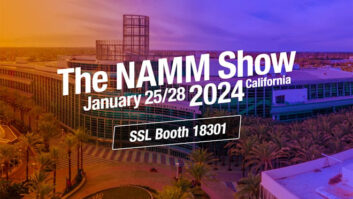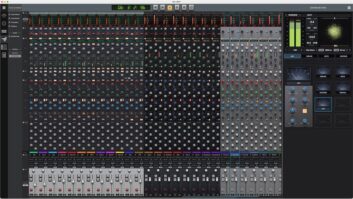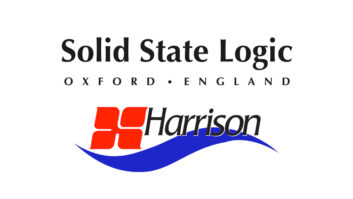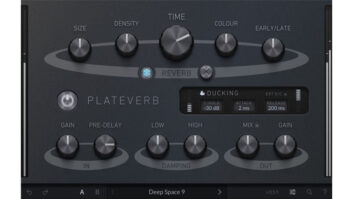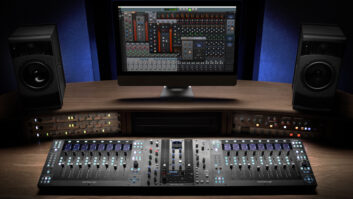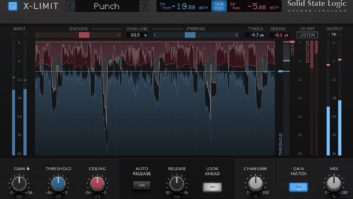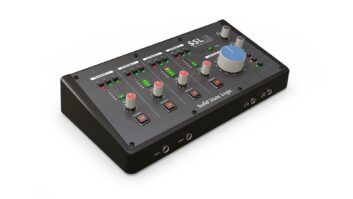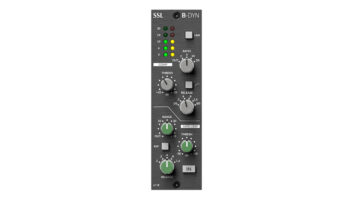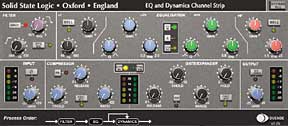
As home and project studios continue to multiply, it’s fitting that SSL is now parting its signature sound into the DAW world. Served up on a custom DSP platform, Duende is an extremely powerful rackmounted hardware and software solution that connects to a computer with a single FireWire cable to deliver console-grade channel strip EQ and dynamics, and the legendary SSL Stereo Bus Compressor to most popular VST, Audio Units and RTAS workstation environments. (At the time of this review, only a Mac OS version of the install disc was shipping; Windows support should be ready by the time you read this.)
SUPERANALOGUE PLUG-INS
Duende functions like SSL’s C200 digital production console, whose algorithms are based on the XL 9000 K SuperAnalogue console. Though the C200’s algorithms are tried and proven, SSL specially tweaked them so that Duende would sound even more authentic.
A quartet of 333MHz, 40-bit, floating-point SHARC DSPs — which are individually more powerful than those in the C200 — crunch numbers inside the 1U box. Despite its rugged mass, Duende’s hardware lacks an internal power supply. The unit is capable of being bus-powered via the 6-pin IEEE-1394/FireWire 400 connectors (1x primary and 1x loop-through) on the rear panel; SSL also supplies a universal wall wart adapter with interchangeable adapters for use in countries that employ different voltage levels.
Duende has a total of 32 virtual processor “slots” available simultaneously at sample rates of 44.1 or 48 kHz (this halves to 16 slots at 88.2 and 96 kHz), each capable of running either channel strips or bus compressors. Because mono instances occupy one slot and stereo two, Duende can only truly function as a 32-channel mixer if you don’t run bus compressors and your session is 48 kHz or less. When you install Duende’s plug-ins on a Mac, a DSP usage panel is installed into Apple Menu > System Preferences.
THE ENGLISH CHANNEL
The channel strip’s 4-band parametric EQ is based on the XL 9000 K’s switchable G and E Series EQ circuitry. The “normal” G-curve shelving EQ has those distinctively aggressive-sounding SSL mids (200 to 2k Hz low/mid; 600 to 7k Hz high/mid) featuring adjustable Q of 0.5 to 2.5 and ±20 dB of gain — plus, there’s over/undershoot on the highs and lows. The LF section operates over a range of 40 to 600 Hz and is capable of up to 16.5 dB of cut or boost. The HF section covers 1.5 to 22 kHz and is capable of ±20dB gain. Both bands can be set to shelving or peaking curves by pressing the Bell button. Engaging the E button removes the over/undershoot effect and provides a slightly gentler slope, with the bandwidth of the HMF and LMF sections remaining constant at all gains.
By default, EQ precedes the filter and dynamics section, but you can easily rearrange these. Pressing the Input button sends the 12dB/octave lowpass filter (20 to 500 Hz) and 18dB/octave highpass filter (3 to 22k Hz) pre-EQ. Each filter, as well as the EQ section, can be independently bypassed or dynamics sidechained, or you can pop the filters into the sidechain together with EQ for simple de-essing and other frequency-controller dynamics processing. If only the filters are assigned to the sidechain, then the EQ comes before them in the signal path. As you make routing adjustments, a block diagram at the bottom of the plug-in window shows you what’s going where.
The dynamics section features a compressor/limiter and expander/gate that work independently, but they can operate simultaneously. Like its hardware counterpart, this section can be placed pre- or post-EQ (but always appears post-filters), and makeup gain is automatically applied to maintain steady output levels. Thankfully, the Version 1.2 update added 20 dB of channel input gain/attenuation with polarity reverse and metering. A similar gain knob and level meter are provided on output, as is an S/C Listen button that routes the sidechain directly to the output for monitoring.
AT THE ARMREST
I installed the plug-ins’ V. 1.2 update and upgraded the Duende firmware to V. 1.14 on my Mac dual 1.8GHz with 4GB RAM, Mac OS 10.4.4 and Pro Tools HD3 Accel hardware with a 192 I/O interface. Mono and stereo versions of both the EQ and Dynamics Channel Strip and Bus Compressor plug-ins are placed into their three respective plug-in — format folders. Although VST and Audio Units versions were natively coded by SSL, Pro Tools users gain support via an invisible RTAS wrapping process licensed by FXpansion. I ran Duende as an RTAS plug-in under Pro Tools HD 7.1 and as an Audio Units plug-in under Apple Logic Pro 7.2.
With Duende sharing the FireWire 400 bus with my audio drives, I achieved full 32-slot processing without a single hiccup or click. However, once I tossed my Focusrite Liquid Mix into the fray, performance became unstable and about half as efficient. Users with multiple DSPs or those who use FireWire audio interfaces will want to add a PCI FireWire card to their systems. My three spaces were already filled with HD Accel cards, so this alternative requires buying into a PCI expansion chassis.
Of course, latency is an issue with all DSP platforms, and Duende is no exception. The good news is that latency is reported to the host for automatic delay compensation (ADC); the bad news is that Pro Tools LE users don’t have the luxury of ADC and must compensate manually or through use of Digidesign’s sample delay plug. For live overdubbing, I’d love to see a Kill button in Duende’s Preference panel that would temporarily bypass the plug-ins wholesale in these instances, similar to the Universal Audio UAD-1. Track-freezing in Logic 7.1, and Steinberg Cubase SX 3 and Nuendo 3 or greater is supported, but this does not free up any of Duende’s resources.
In terms of sound, this is the real deal. As with analog units, boosting the EQ favorably colors the signal with very natural-sounding phase smearing, remaining smooth even under extremes; things never seemed to get too brittle or grainy-sounding. The aggressive G Series settings make for meaty mids and emphatic ends — great for sculpting electric guitars and vocals. Similarly, cutting is a smooth process and doesn’t impart that clinical emptiness that is typical of many EQs. The high- and lowpass filters have a gorgeously transparent sound that doesn’t display the annoying “ring” you often get around the cut-off peak of many other filters.
Compared to Waves’ SSL emulations, for example, I’d have to say that Duende’s EQ and Channel Compressor seemed fuller, with more depth and punch. Likewise, the Bus Compressor plug-in absolutely nails the classic. Used subtly, it sounds as though it’s gently riding drum overhead or instrument group faders to glue your mix together magically. The harder you push it, the thicker, rounder and more authoritative it sounds, infusing gobs of analog saturation, density and smack in a pleasant and musical way.
POWERING DOWN
Duende retails for about the same price as the TDM version of Waves’ emulation, which runs roughly only half as many instances on a card that costs more than double Duende’s asking price. Knowing that the SSL plugs will run consistently using their finite DSP resources (rather than consuming a lion’s share of your already taxed and fluctuating CPU) is well worth the investment, not to mention the fact that Duende sounds absolutely amazing and outperforms all the imposters with a cleaner, more aggressive and modern tonal character, thanks to the XL 9000 K’s legacy.
Duende is also very beneficial for mobile users, capable of taking the mixing strain off of laptop systems and placing it firmly in your travel rack. Now every room can truly be an SSL room.
Price: $1,899.
Solid State Logic, 212/315-1111, www.solid-state-logic.com.
Jason Scott Alexander is a producer/mixer/remixer in Ottawa, Ontario.
